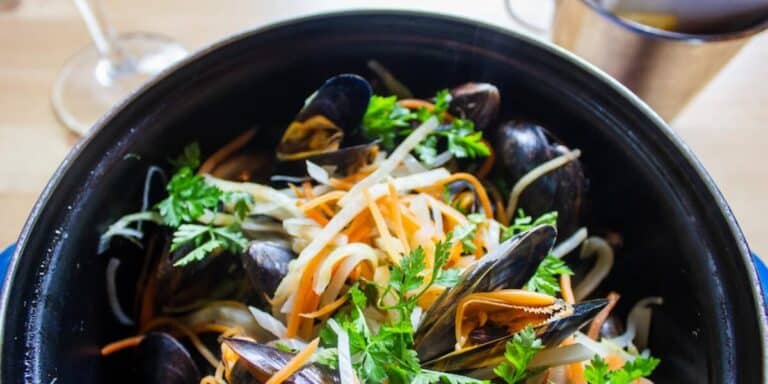Oven Baked Beef Ribs
You may not be aware that beef ribs can be just as tender and flavorful as pork ribs, but it all starts with choosing the right cut. Beef back ribs and short ribs are ideal for oven-baking, as they have a decent amount of meat covering the bones. By cooking them low and slow, the connective tissue breaks down, resulting in fall-off-the-bone tenderness. But that’s only half the battle – the real key to perfect oven-baked beef ribs lies in the preparation and seasoning. And that’s where things can get a little tricky.
Key Takeaways
- Beef back ribs and short ribs are ideal for oven-baked beef ribs due to their decent amount of meat covering the bones.
- Choose ribs with a decent meat-to-bone ratio and avoid visible signs of damage or excessive fat for best results.
- Cooking beef ribs at low temperatures below 300°F prevents flare-ups and promotes even cooking and tenderization.
- Lengthy cooking times at low heat break down fat and connective tissue, resulting in fall-off-the-bone tender ribs.
- Beef back ribs and short ribs can be found in the same section as beef shanks or stew meat at the store.
Choosing the Right Ribs
To get started with oven-baked beef ribs, you’ll want to choose the right type of ribs, specifically looking for beef back ribs or beef short ribs, which are meatier and more suitable for slow-cooking. You won’t want to opt for beef spare ribs, as they’re often too thin and might not hold up well to long cooking times. When selecting beef back ribs, look for a rack with a decent amount of meat covering the bones, as this will guarantee they stay tender during cooking.
You’ll usually find beef back ribs in the meat department of most supermarkets, and they might be labeled as ‘beef back ribs’ or ‘beef ribs.’ If you can’t find them, don’t hesitate to ask your butcher for assistance. They can help you locate the right cut or even order some for you if they’re not in stock.
Beef short ribs, on the other hand, are often found in the same section as beef shanks or beef stew meat. They’re usually shorter and more compact than beef back ribs, with a lot of meat and connective tissue that breaks down beautifully during slow-cooking. Regardless of which type of ribs you choose, make sure to check the packaging for any visible signs of damage or excessive fat, as this can affect the overall quality of your oven-baked beef ribs.
Preparing the Rib Rub
Now that you’ve selected the perfect ribs, it’s time to prepare the rib rub that’ll elevate their flavor. You’ll start by mixing together dry ingredients like paprika, brown sugar, and garlic powder, and choosing a pre-made spice blend can simplify the process. By understanding how to balance and adjust the ratios of these ingredients, you’ll create a rub that complements the rich flavor of the beef ribs.
Mixing Dry Ingredients
You’ll start by combining paprika, brown sugar, garlic powder, salt, black pepper, and your other preferred spices in a small bowl to create the dry rub. Don’t worry too much about the proportions at this stage; you can always adjust to taste later. Simply add a few tablespoons of each ingredient and mix until well combined.
As you mix the dry ingredients, make sure to break up any clumps, especially if you’re using a finer powder like garlic or onion powder. This guarantees that your rub is evenly textured and will distribute evenly over the ribs. You can also use a whisk or small sifter to help blend the spices and remove any lumps.
Once the dry ingredients are well mixed, take a moment to appreciate the aroma filling the air – it’s a great indication of the flavor to come! Now, it’s time to move forward with preparing the rest of the rib rub, knowing you’ve got a solid foundation of spices. Your dry rub is just the start, but it’s a vital step in achieving tender, flavorful oven-baked beef ribs.
Choosing Spice Blends
Selecting the right spice blends is crucial in preparing the rib rub, as it will enhance the overall flavor profile of your oven-baked beef ribs. You want to choose a blend that complements the natural flavor of the beef without overpowering it. With so many options available, it can be overwhelming to decide which one to use.
- Classic BBQ Blend: A mix of paprika, garlic powder, onion powder, salt, and black pepper that adds a smoky, savory flavor to your ribs.
- Spicy Tex-Mex Blend: A combination of chili powder, cumin, smoked paprika, and cayenne pepper that gives your ribs a bold, spicy kick.
- Herby Mediterranean Blend: A blend of oregano, thyme, rosemary, garlic powder, and lemon peel that adds a bright, herby flavor to your ribs.
When choosing a spice blend, think about the flavor profile you want to achieve and the type of ribs you’re using. You can also experiment with different blends to create your own unique flavor. Remember, the key is to enhance the natural flavor of the beef without overpowering it.
Adjusting Rub Ratios
To create the perfect rib rub, adjusting the ratio of spices to suit your taste preferences is essential. You can’t just throw a bunch of spices together and hope for the best. You need to think about what flavors you want to dominate and which ones should take a backseat. For example, if you like a little heat, you can increase the amount of cayenne pepper or red pepper flakes. If you prefer a sweeter rub, you can add more brown sugar or honey.
As you experiment with different ratios, keep in mind that it’s better to start with a small batch and adjust to taste. You can always add more of a particular spice, but it’s harder to remove excess spice from the mix. Also, remember that the flavor of the rub will mellow out a bit during cooking, so don’t be afraid to be a bit bold with your adjustments. With a little trial and error, you’ll find the perfect balance of flavors to make your oven-baked beef ribs truly unforgettable. By tweaking the rub ratio, you’ll be able to create a dish that’s tailored to your unique taste preferences.
Seasoning the Ribs
Now that you’ve prepared your rib rub, it’s time to start seasoning the ribs. You’ll want to choose the right seasonings to enhance the natural flavor of the beef, and decide whether a dry rub or marinade is the way to go. By making a few key decisions, you can create a flavor profile that’s both delicious and uniquely yours.
Choosing the Right Seasonings
Your beef ribs’ flavor profile will largely depend on the seasonings you choose, so it’s crucial to pick a blend that complements the natural taste of the beef. With so many seasoning options available, it can be overwhelming to decide on the perfect blend. However, by considering a few key factors, you can make an informed decision.
When selecting seasonings, think about the flavor profile you want to achieve. Do you prefer a sweet and smoky taste or a spicy and tangy one? You should also consider the ingredients in the seasoning blend to guarantee they complement the beef without overpowering it.
Three essential considerations when choosing seasonings are:
- Aroma: Opt for a blend with aromatic ingredients like garlic, onion, or paprika to add depth to your ribs.
- Flavor Profile: Choose a seasoning that complements the natural taste of beef, such as a blend with notes of black pepper, salt, or thyme.
- Intensity: Select a seasoning with the right level of intensity, as some blends can be overpowering if used in excess. By considering these factors, you’ll be able to find the perfect seasoning blend for your oven-baked beef ribs.
Dry Rub Vs Marinade
Deciding between a dry rub and a marinade is a crucial step in seasoning the ribs, as it’ll determine how the flavors penetrate the meat. You’ll want to ponder the type of flavor profile you’re aiming for and the texture of the ribs. A dry rub is a great option if you want a crusty exterior and a tender interior. It’s a mixture of spices, herbs, and sometimes sugar that you rub directly onto the meat. This method allows the flavors to penetrate the meat slowly, resulting in a rich and intense flavor.
On the other hand, a marinade is a liquid mixture that the ribs soak in before cooking. This method is great for tenderizing tougher cuts of meat and adding a lot of flavor quickly. The acidity in the marinade helps break down the proteins, making the meat more tender. However, be careful not to over-marinate, as this can make the meat mushy. Ultimately, the choice between a dry rub and a marinade comes down to personal preference and the type of ribs you’re using. Both methods can produce delicious results, so don’t be afraid to experiment and find what works best for you.
Enhancing Flavor Profiles
The ribs’ flavor profile can be greatly enhanced by adding aromatics, spices, and herbs that complement their natural beefy taste. You can mix and match different seasonings to create a blend that suits your taste buds. When seasoning the ribs, don’t be shy – you want to coat them evenly, making sure every bite is packed with flavor.
Three essential seasoning combinations to try:
- Classic BBQ: paprika, brown sugar, garlic powder, salt, and black pepper. This blend is a staple for a reason – it’s sweet, smoky, and savory all at once.
- Spicy Tex-Mex: chili powder, cumin, smoked paprika, lime zest, and cayenne pepper. If you like a little heat, this blend will add a bold, spicy kick to your ribs.
- Herby Mediterranean: oregano, thyme, lemon zest, garlic powder, and salt. This invigorating blend is perfect for spring and summer, with bright, herby flavors that pair beautifully with beef.
Building the Rib Glaze
With all the ingredients ready, start by whisking together ketchup, brown sugar, apple cider vinegar, and Worcestershire sauce in a medium-sized bowl. You’re creating the foundation of your rib glaze, and this mixture will provide a sweet, tangy, and savory flavor profile.
As you whisk, consider the roles each ingredient plays. The ketchup adds a rich, fruity flavor, while the brown sugar contributes a deep sweetness. Apple cider vinegar provides a tangy kick, and Worcestershire sauce adds a savory, umami taste.
| Ingredient | Quantity | Notes |
|---|---|---|
| Ketchup | 1/2 cup | Use a high-quality, unsweetened ketchup |
| Brown sugar | 1/4 cup | Dark brown sugar adds a deeper flavor |
| Apple cider vinegar | 2 tbsp | Use a raw, unfiltered vinegar |
| Worcestershire sauce | 1 tbsp | Look for a brand with minimal added sugars |
| Smoked paprika | 1 tsp | Optional, for a smoky flavor boost |
Whisk the mixture until it’s smooth and well combined. Taste it and adjust the seasoning as needed. If you prefer a thicker glaze, add a little more brown sugar or ketchup. If you prefer a thinner glaze, add a little more apple cider vinegar. Set the glaze aside, ready to be brushed onto your ribs later. You’ll be amazed at how this simple mixture elevates the flavor of your oven-baked beef ribs.
Assembling the Ribs
Assembling your oven-baked beef ribs begins by seasoning the ribs generously with salt, pepper, and any other dry rub ingredients you’ve chosen, making sure to coat all surfaces evenly. Don’t be shy with the seasoning – you want a nice crust to form on the ribs as they bake. Next, line a large baking sheet with foil or parchment paper to make cleanup a breeze.
Now, place the seasoned ribs on the prepared baking sheet in a single layer, bone side down. You want to leave a little space between each rib to allow for even cooking and glaze distribution. If you’re feeling fancy, you can create a rib "rack" by standing the ribs upright on their sides, but this isn’t necessary.
As you assemble the ribs, keep the following tips in mind:
- Keep the ribs in a single layer to prevent them from steaming instead of browning.
- Leave space between each rib for even cooking and glaze distribution.
- Save the glaze for the end – don’t brush the ribs with glaze yet, as it’ll just burn in the oven.
Baking the Ribs to Perfection
You’ll want to preheat your oven to 300°F (150°C), a relatively low temperature that’s perfect for slow-cooking tender, fall-off-the-bone beef ribs. This low heat will help break down the connective tissue in the meat, resulting in a deliciously tender final product. While your oven is heating up, take a moment to cover your baking sheet with aluminum foil – this will help with cleanup later.
Place the assembled ribs on the prepared baking sheet, bone side down. You want to make sure they’re in a single layer, so if necessary, use multiple baking sheets to accommodate all the ribs. Now, cover the ribs with foil, creating a tight seal around the edges of the baking sheet. This will help trap moisture and promote even cooking.
With your ribs all set, pop them into the oven and let them cook for about 2 1/2 hours. You’ll know they’re getting close when the meat starts to pull away from the bone. After 2 1/2 hours, remove the foil and continue baking for an additional 15-20 minutes. This will help the ribs develop a nice brown color and a bit of caramelization on the surface. Keep an eye on them during this time to guarantee they don’t overcook.
Resting and Serving Ribs
Once the ribs have finished baking, it’s time to let them rest for a few minutes before serving, allowing the juices to redistribute and the meat to relax. You’ve waited this long, so don’t rush it now! Letting the ribs rest will make them even more tender and flavorful.
During this time, you can start getting your sides ready to go. You know, the usual suspects: coleslaw, baked beans, or maybe some grilled veggies. Whatever you choose, you can’t go wrong.
Now that your mouth is watering, here are three things to keep in mind when serving your oven-baked beef ribs:
- Cut the ribs in a way that makes sense: You can either cut them into individual portions or leave them in a big, messy slab. Either way, you can’t go wrong.
- Garnish with fresh herbs: A sprig of rosemary or a few leaves of thyme can really elevate the presentation of your ribs.
- Have plenty of napkins on hand: Let’s be real, ribs can be messy, so be prepared with plenty of napkins to go around.
When you’re ready to serve, just slice the ribs up and get ready for the oohs and aahs from your guests. The resting time has allowed all the juices to redistribute, and the meat is tender and falling off the bone. You’ll be the hero of the party with these oven-baked beef ribs!
Frequently Asked Questions
Can Beef Ribs Be Cooked in Advance and Refrigerated?
Like a master chef charting a culinary storm, you’ll find that cooking beef ribs ahead of time is a safe harbor. You can cook them in advance and refrigerate, but reheat carefully to avoid dryness, lest your dish be shipwrecked.
How Do You Store Leftover Oven-Baked Beef Ribs?
You’ll want to store leftovers in a sealed container to keep them fresh. You can use a glass or plastic container with a tight-fitting lid, and it’s best if you press plastic wrap or aluminum foil directly onto the meat.
Can Beef Ribs Be Frozen Before or After Baking?
You can freeze beef ribs before or after baking, but you’ll get better results if you freeze them before. Freezing raw ribs preserves their texture and flavor, while freezing cooked ribs can make them a bit tougher.
What Are Some Common Mistakes to Avoid When Baking Beef Ribs?
‘As you undertake a culinary adventure, don’t let rookie mistakes leave you high and dry! You’ll want to avoid overcooking, not letting the ribs rest, and not removing the membrane to guarantee fall-off-the-bone tenderness.’
Can You Use a Slow Cooker Instead of the Oven for Beef Ribs?
You’re wondering if a slow cooker can replace the oven for tender beef ribs? Actually, you can, and it’s a fantastic alternative! You’ll get fall-off-the-bone ribs with minimal effort, and it’s perfect for busy days.






